The poverty rate in the U.S. is expected to further increase in 2021, after having been on the rise for the past two consecutive years. Thus, in 2021, one in seven Americans or 13.7% of the population is estimated to have resources below the poverty rate, according to the “2021 Poverty Projections” brief drafted by the Washington D.C.-based think tank, Urban Institute. This estimate is up by 2.3% from the official 11.4% poverty rate recorded in 2020 and up 3.2% against the 10.5% poverty rate recorded in 2019. This trend is arousing concerns, the more so as this is the first increase in poverty in the world’s largest national economy after five consecutive annual declines.
The institute identified that of the 13.7% Americans living in poverty, 4.4% were in deep poverty and 45% had resources less than twice the poverty rate. The worst-hit were non-Hispanic black people and Hispanic people, who were twice as much affected by poverty as white Americans.
The poverty rates in the United States are updated on an annual basis by the Census Bureau. The thresholds and guidelines applied to a family’s income determine its poverty status and vary according to the size of a family. Based on the numbers from previous years and the estimations of future trends, the 2021 annual poverty threshold for a family of four was set at US$26,500.
Who are those living in hardship in the U.S. and why?
PovertyUSA, a catholic initiative addressing poverty issues, has ascertained that the most affected by poverty are:
- People working multiple jobs but receiving minimum wages;
- Elderly people living on a fixed income and being unable to afford their medicines;
- People with disabilities;
- Those who are suddenly out of work and have no savings;
- Millions of families across the country, both in urban and rural communities.
Both the above-mentioned reports and analysis conclude that addressing poverty through affordable housing, reliable public transport, access to healthcare and nutritious food, livable wage jobs, a restorative criminal justice system, funded schools, community development with safe neighborhoods, and economic development, in general, would increase productivity and earnings and would generate an improvement in education and health, consequently yielding other lasting benefits for sustainable development.

